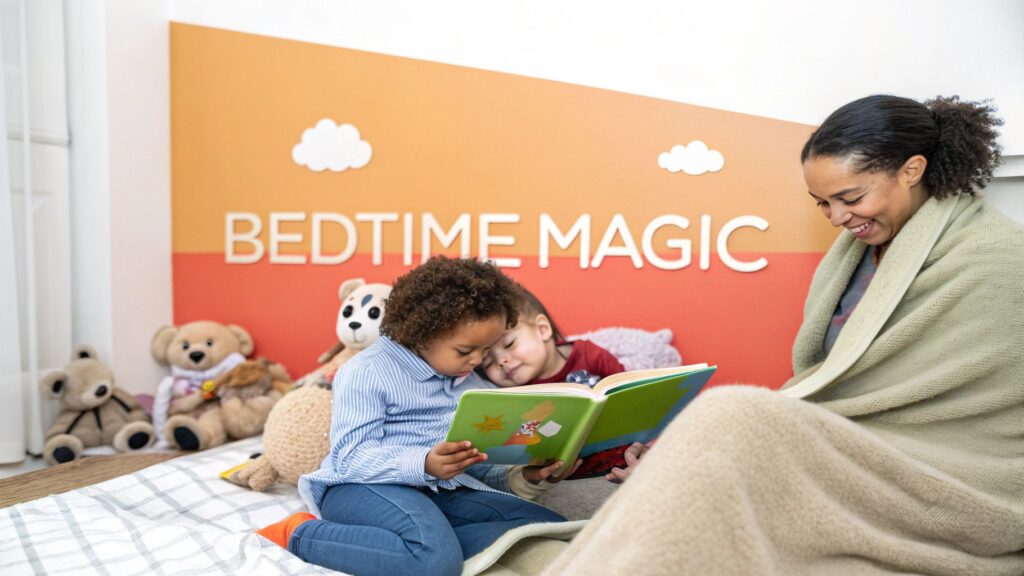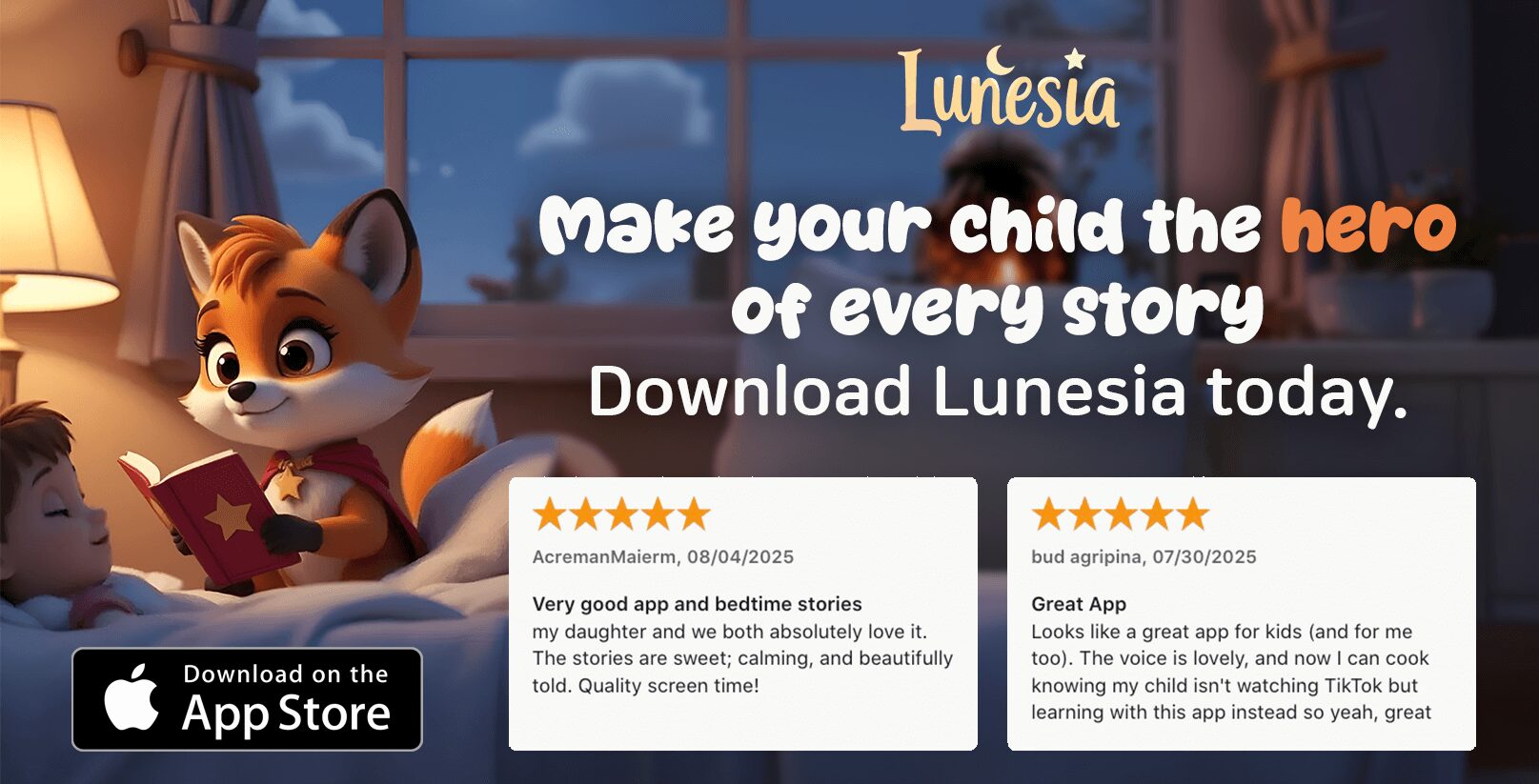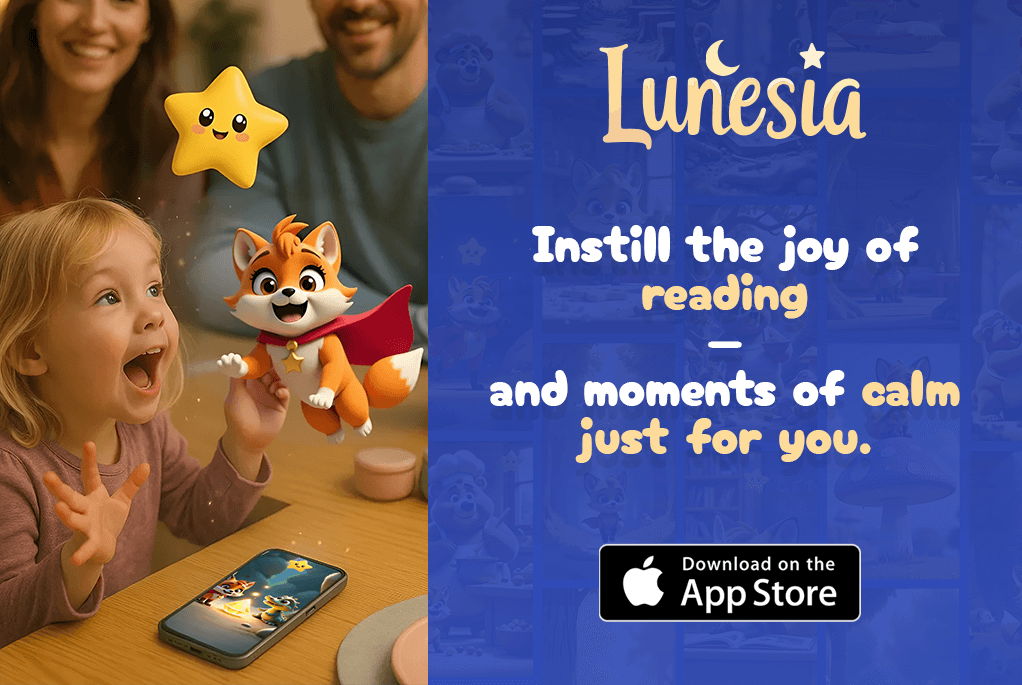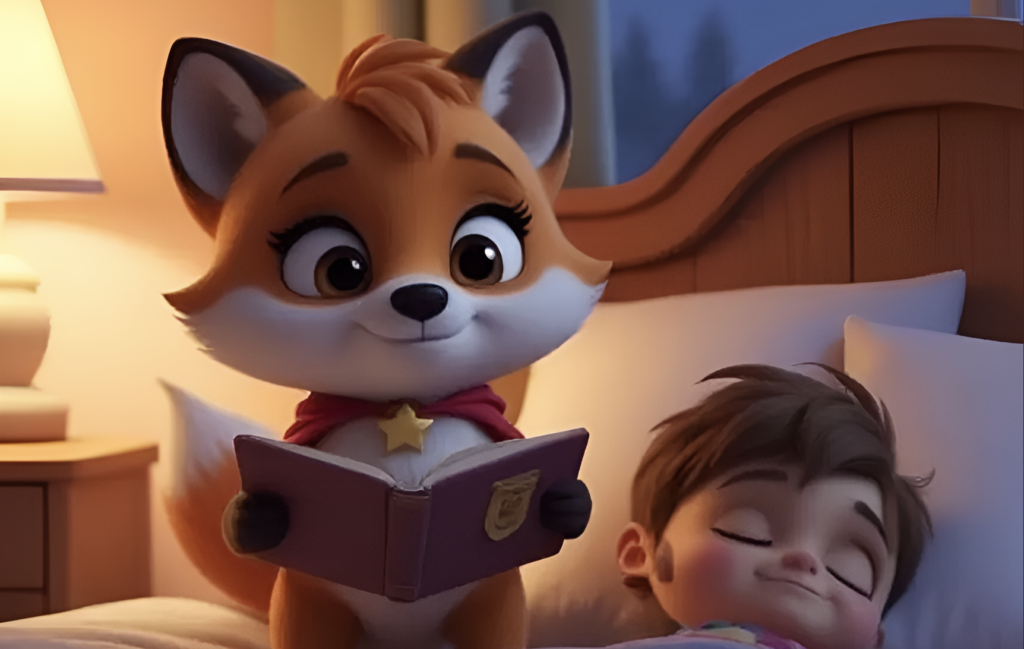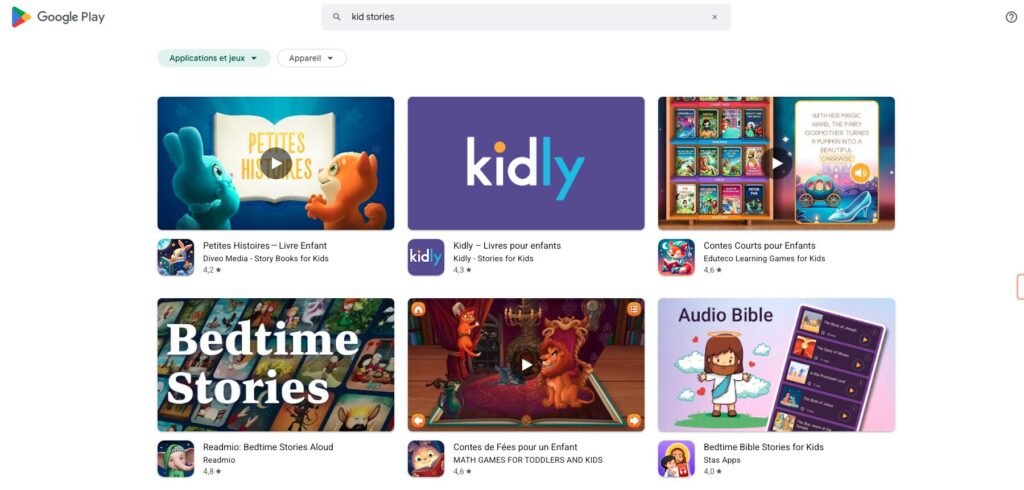Is the end of a long day feeling more like a battle than a cuddle? You're searching for that perfect, magical way to help your three-year-old wind down. You know a good bedtime story is the secret ingredient for a peaceful night, but which one actually works? Finding the right stories is about so much more than just lulling them to sleep; it’s a golden opportunity to connect, spark their imagination, and gently teach the lessons that matter. Think about it: this nightly ritual is actively shaping how they see the world, helping them process the day's big feelings and building resilience for whatever tomorrow brings.
But what if story time could do even more? What if it could be a tool that not only calms them down but also builds their character? Beyond classic books, modern interactive stories empower children to become the hero of their own adventure. An app like Lunesia offers incredible journeys where your child’s decisions shape the outcome, teaching them problem-solving, kindness, and empathy in a completely safe, ad-free world. And the bonus for you? While they're deeply engaged in a story that builds courage and compassion, you get a moment of precious, guilt-free peace.
This guide will explore the best bedtime stories for 3 year olds, from timeless classics to these innovative interactive tales. We’ll share practical, concrete tips to make every story an experience that strengthens your bond and supports their growth. After all, a truly magical bedtime is about more than just a story—it’s about creating a comforting environment, perhaps with their favorite soft, cozy children's blanket. Let's discover the stories that will make your nightly routine the best part of everyone's day.
1. 'Goodnight Moon': The Ultimate Calming Classic
Ever wonder why a simple story about a bunny saying goodnight has captivated families for over 75 years? 'Goodnight Moon' isn't just a book; it's a carefully crafted lullaby in print, making it one of the most effective bedtime stories for 3 year olds.
Its magic lies in a powerful combination of rhythm and repetition. Have you noticed how this creates a predictable, soothing ritual that signals to your child's buzzing brain that it's finally time to wind down? The genius is in the details: as you turn the pages, the room in the illustrations gradually darkens, subtly mirroring the transition from a busy day to a quiet night. This isn’t just a story; it's a sleep-trigger.
Making the Classic Interactive
While 'Goodnight Moon' is a passive listening experience, you can layer in interactive elements to deepen its calming effects and build your child's observation skills.
- Play "I Spy" Before the Story: Before you even start reading, spend a moment on the first page of the "great green room." Ask your three-year-old, "Can you find the red balloon?" or "Where are the little kittens?" This simple game instantly focuses their attention and anchors them in the present moment, pulling them away from the day's chaos.
- Echo the "Goodnights": Encourage your child to whisper "goodnight" along with you to each object. This participation makes them an active part of the calming-down process, giving them a sense of control and routine they crave.
- Connect to Their Own Room: After saying goodnight to the things in the bunny's room, create your own "goodnight" ritual. Softly say goodnight to the lamp, the window, and their favorite stuffed animal in their own bedroom. This reinforces the universal signal for sleep in a way that feels personal and safe.
Why This Ritual Works
That predictability is its superpower. For a three-year-old whose world is full of new, sometimes overwhelming, experiences, a consistent and gentle routine provides a profound sense of security. Research consistently shows that bedtime routines improve sleep in young children. This ritual helps them transition from the high energy of the day to the quiet calm of the night, reducing bedtime anxiety. This classic book lays the perfect foundation for a peaceful night's rest, proving that sometimes the simplest stories hold the most power.
2. 'The Going to Bed Book': Turning Routine into a Playful Ritual
What if you could make the nightly scramble of brushing teeth and putting on pajamas feel less like a chore and more like a game? Sandra Boynton's 'The Going to Bed Book' does exactly that, transforming the bedtime routine into a delightful and silly adventure, making it one of the most beloved bedtime stories for 3 year olds.
The book follows a cast of quirky animals on a boat as they get ready for bed. Its bouncy, unforgettable rhyme and simple, clear steps make the entire process of winding down feel fun and predictable. For a three-year-old who might resist the transition to bed, this story reframes the routine as a shared, happy experience rather than a set of demands.
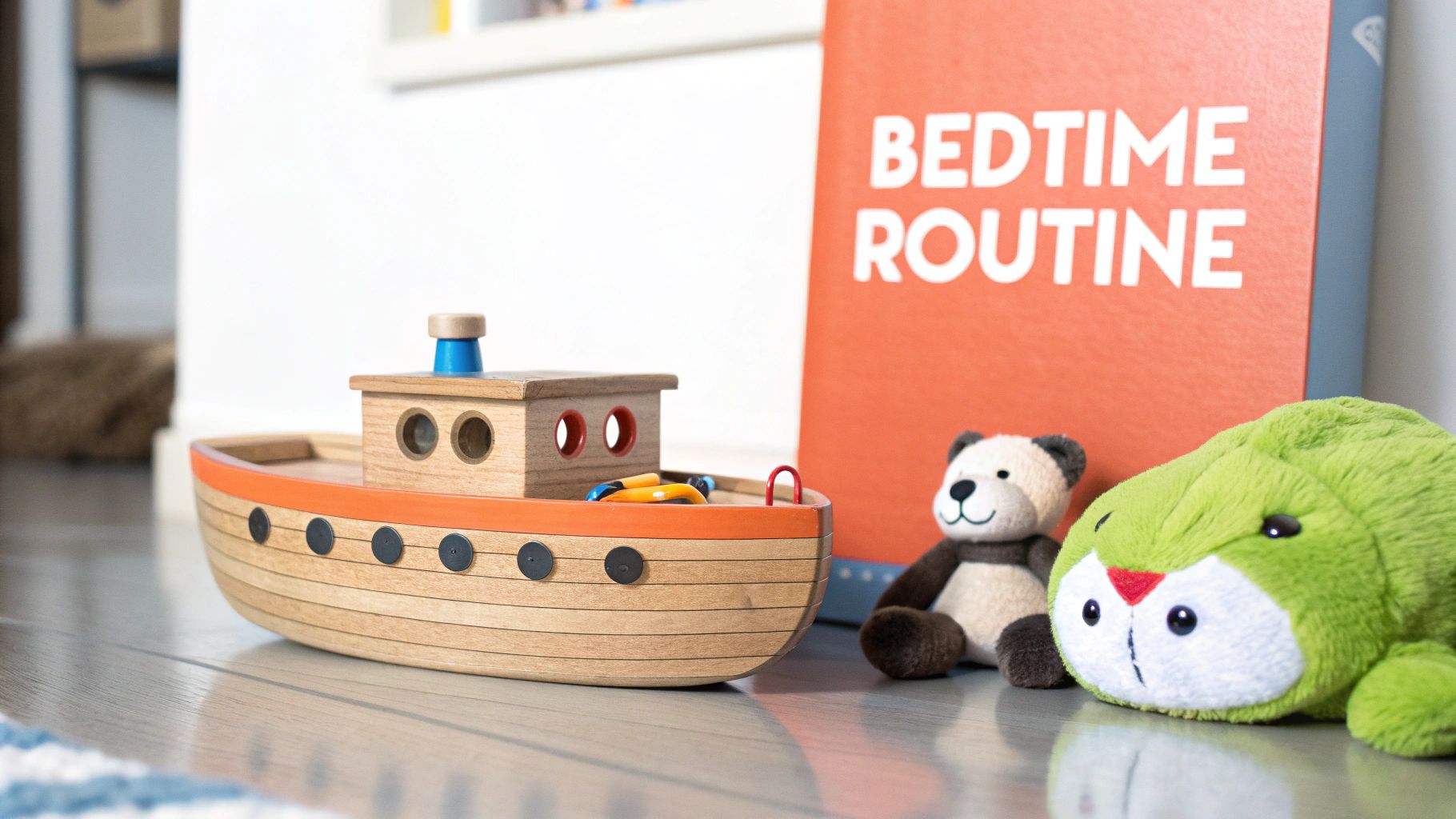
Making the Classic Interactive
This book is a fantastic tool for hands-on learning, turning passive reading into active participation. By connecting the story directly to your child's own actions, you empower them to take charge of their bedtime routine.
- Act It Out Together: As you read about the animals taking a bath, brushing their teeth, and putting on their "pajamas big and small," act out the motions with your child. Mime scrubbing behind your ears or pretend to brush your teeth with a giant toothbrush. This kinetic connection makes the steps memorable and fun.
- Use It as a "Routine Checklist": Turn the book into a visual guide for your own bedtime process. After reading a page, say, "The animals just brushed their teeth! Is that what we do next?" This gives your child a sense of accomplishment as they complete each real-life step along with the characters.
- Rock with the Rhythm: In the end, the animals "rock and rock and rock to sleep." Use this as a cue to gently rock your child, transitioning from the book's playful energy into a final, soothing motion that signals it’s time for sleep. It’s a perfect lead-in to other quiet time activities for preschoolers.
Why This Ritual Works
For a three-year-old, mastering a sequence of events is a major cognitive milestone. 'The Going to Bed Book' provides a simple, repeatable script that builds their confidence and reduces bedtime battles. By making the routine predictable and playful, you’re not just reading a story; you’re teaching your child essential self-care skills and associating bedtime with security and fun. This playful approach is a powerful way to end the day on a positive, peaceful note.
3. 'The Runaway Bunny': A Hug in a Book
What if your child's bedtime fears could be soothed before they even begin? 'The Runaway Bunny', from the same author-illustrator duo as 'Goodnight Moon', is a masterpiece of emotional reassurance. This story addresses a core anxiety for young children: separation. It’s a powerful narrative that makes it one of the most comforting bedtime stories for 3 year olds.
The book's brilliance lies in its gentle, repeating promise of unconditional love. A little bunny imagines all the ways he could run away, and his mother calmly and lovingly responds with all the ways she would find him. This back-and-forth isn't just a story; it's a therapeutic dialogue that builds a profound sense of security, directly countering the fears that can surface when the lights go out.
Making the Classic Interactive
You can transform this story from a simple reading into a powerful bonding ritual that reinforces its message of safety and love, helping your child build emotional resilience.
- Make it Personal: After reading a few pages, pause and ask, "If you became a little bird, where would you fly?" Then, adapt the mother bunny's response: "Well, then I would be the wind and blow you gently right back to your cozy bed." This personalizes the promise of safety.
- Create a "Finder" Game: During the day, play a gentle version of hide-and-seek inspired by the book. When you find your child, give them a big hug and say, "I will always find you!" This physicalizes the book's core message, connecting it to fun and affection.
- Trace with a Finger: As the mother bunny becomes a tree or a fisherman, gently trace the shapes on your child’s back or arm. This sensory input is incredibly grounding and calming, helping them relax and feel your constant, loving presence.
Why This Ritual Works
For a three-year-old, the concept of a parent always being there is abstract. This story makes that promise tangible. The repetitive and unwavering nature of the mother's love provides a solid foundation of security that can quiet a racing mind at bedtime. It addresses the root of many bedtime struggles: the fear of being alone. By internalizing the message that they are unconditionally loved and safe, children are better equipped to drift off to sleep peacefully, feeling secure and cherished.
4. 'Pajama Time!': Transforming Bedtime Battles into a Party
What if the most dreaded part of bedtime, changing into pajamas, could become the most fun? Sandra Boynton’s 'Pajama Time!' achieves just that, turning a nightly chore into a joyful, energetic celebration. This book is a secret weapon for parents of pajama-resistant toddlers, making it one of the most practical bedtime stories for 3 year olds.
Its genius lies in its infectious, toe-tapping rhythm and silly animal characters. The story validates a child’s desire to move and play while cleverly redirecting that energy toward the goal of getting ready for bed. It’s less of a story and more of a musical anthem for pajamas, reframing the routine from a power struggle into a delightful dance party.
Making the Book an Active Ritual
'Pajama Time!' is designed for movement. Instead of just reading it, you can transform the entire pre-bed routine into an engaging game that builds positive associations with bedtime.
- Create a "Pajama Dance": As you read the catchy "Pajammy to the left. Pajammy to the right," turn getting dressed into a dance. Wiggle one leg into the pajama pants, then the other. Do a little shimmy as you pull the top over their head. This makes them an enthusiastic participant rather than a reluctant one.
- Let Them Choose Their Pajama "Costume": Empower your three-year-old by letting them choose their pajamas for the night. You can ask, "Do you want to be a stripy zebra like in the book, or a polka-dot elephant?" This small choice gives them a sense of autonomy, which dramatically reduces resistance.
- Use it as a Transition Tool: This book is perfect for the start of the wind-down routine, not the end. Use its high energy to get through brushing teeth and changing clothes, then follow it with a much calmer, quieter story to signal that the "party" is over and it's time for sleep.
Why This Ritual Works
For a three-year-old, transitions are often the hardest part of the day. 'Pajama Time!' brilliantly bridges the gap between active playtime and quiet bedtime by making the transition itself a form of play. It channels their boundless energy constructively, preventing the meltdowns that can arise from abrupt changes. By associating pajamas with fun, dancing, and silliness, you’re not just getting them dressed; you're building a positive and tear-free foundation for a peaceful night.
5. 'Guess How Much I Love You': A Tender Hug in a Book
How do you explain a love that feels as big as the sky? 'Guess How Much I Love You' captures this profound feeling in a gentle, accessible narrative, making it one of the most heartwarming bedtime stories for 3 year olds. The story follows Little and Big Nutbrown Hare as they compete to express their boundless affection, turning a simple sentiment into a beautiful, tangible game.
This book does more than tell a story; it wraps a child in a cocoon of emotional security right before they drift off to sleep. The gentle back-and-forth between parent and child hare normalizes expressing big emotions, reinforcing the unwavering bond you share. It’s a powerful, quiet affirmation of love that soothes anxieties and fills a child’s heart, preparing them for a peaceful night.

Making the Classic Interactive
Transform this sweet story into a physical and emotional bonding experience that your three-year-old will cherish. The goal is to connect the words on the page to the love felt in the room.
- Act It Out Together: When Little Nutbrown Hare stretches his arms "as wide as they could go," encourage your child to do the same. When he reaches "as high as he could reach," stretch your arms up together. This physical expression helps them internalize the story's message of immense love.
- Create Your Own "I Love Yous": After reading, start your own version of the game. Ask, "How much do you love me?" and delight in their creative answers. You can say, "I love you more than all the cars on the street," and they might reply, "I love you more than all the dinosaurs!" This fosters creativity and deepens your connection.
- End with a "Moon and Back" Hug: Conclude your storytime ritual by recreating the book's iconic ending. Give your child a big, gentle hug and whisper, "I love you right up to the moon… and back." This creates a powerful and consistent sleep cue associated with ultimate love and safety.
Why This Ritual Works
For a three-year-old, abstract concepts like love can be hard to grasp. This book makes the feeling concrete and measurable in a playful, reassuring way. This ritual doesn't just end the day; it fills your child's emotional tank, reinforcing that they are unconditionally loved and safe. It addresses the deep-seated need for security, which is the foundation for confident, resilient children. By turning reading into an act of love, you’re not just preparing them for sleep; you're building a bedrock of emotional well-being that will last a lifetime.
6. 'Brown Bear, Brown Bear, What Do You See?': Building Confidence Through Rhythm
What if a story could make your three-year-old feel like a confident reader before they even know their ABCs? That's the power of Bill Martin Jr.'s masterpiece, 'Brown Bear, Brown Bear, What Do You See?', a rhythmic chant that is one of the most engaging bedtime stories for 3 year olds.
Its brilliance lies in its sheer predictability. The simple, repetitive question-and-answer format creates a pattern that children can grasp almost instantly. Paired with Eric Carle’s bold, colorful animal collages, the story becomes an irresistible invitation for a child to join in, turning a passive listening experience into an active, confidence-boosting performance. This isn't just a book; it's a child's first step toward literacy and participation.
Making the Classic Interactive
While 'Brown Bear' is naturally interactive, you can enhance the experience to build vocabulary, memory, and a sense of shared accomplishment.
- Create a "Fill-in-the-Blank" Game: After the first few pages, pause before revealing the next animal. Ask, "Brown Bear, Brown Bear, what do you see? I see a…" and let your child gleefully shout the name of the "red bird" or "yellow duck." This simple act of recall makes them feel proud and smart.
- Assign Animal Voices: Give each animal a unique sound. A deep, rumbly voice for the bear, a high-pitched chirp for the red bird, and a quack for the duck. Encourage your child to make the voices with you, adding a layer of silly, sensory fun to the calming routine.
- Connect Colors to Their World: When you see the "blue horse," ask, "What else in your room is blue?" This bridges the gap between the story and their own environment, reinforcing color recognition in a meaningful way and settling them into their sleep space.
Why This Ritual Works
The rhythmic, sing-song nature of 'Brown Bear, Brown Bear, What Do You See?' acts like a metronome for a busy toddler's brain, helping it slow down and prepare for sleep. For a three-year-old, being able to predict and participate in the story provides a powerful feeling of mastery and security. It reassures them that they understand their world, which is a profoundly comforting thought at bedtime. This classic book transforms the end of the day into a moment of shared joy and achievement, paving the way for a peaceful and confident night's sleep.
7. 'Llama Llama Red Pajama': Taming Bedtime Anxieties
What if a story could give your child the exact words for their biggest bedtime fears? 'Llama Llama Red Pajama' does just that, transforming a common nighttime meltdown into a powerful lesson on security and reassurance, making it a must-have in your collection of bedtime stories for 3 year olds.
This book taps directly into the separation anxiety that many three-year-olds experience. It follows Little Llama as his small worries escalate into a full-blown "llama drama" when his mama doesn't return immediately. The story’s genius is in validating these big feelings—showing it’s okay to feel scared—while gently guiding your child toward a comforting resolution. With stories like this, you're not just reading; you're teaching emotional intelligence.
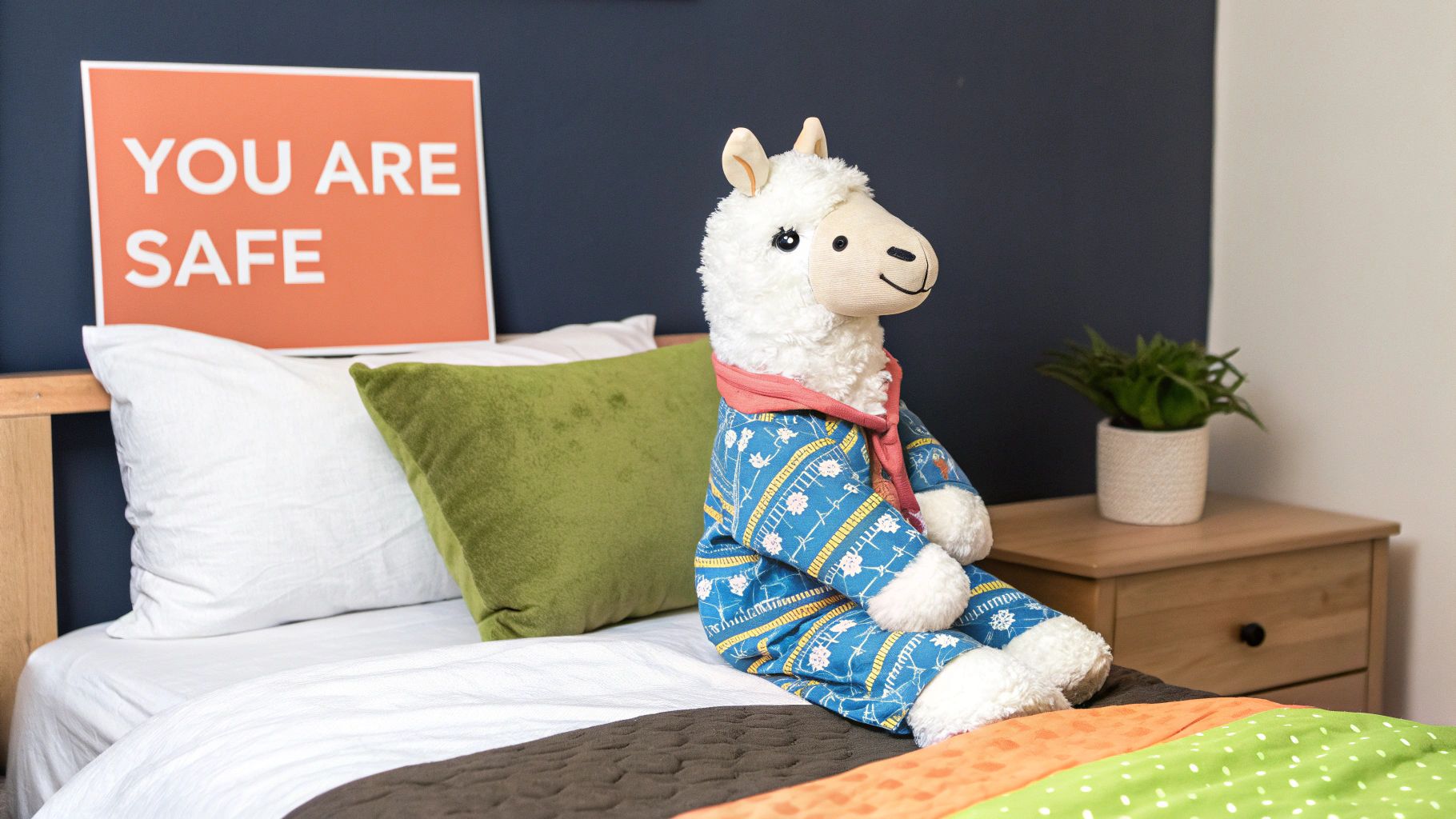
Making the Classic Interactive
Instead of just reading about Little Llama’s panic, you can use this story as a tool to build your child's own emotional resilience and create a secure bedtime routine.
- Name the Feelings: When Little Llama starts to fret, pause and ask, "How do you think Llama Llama is feeling right now? Is he scared? Worried?" Giving your child the vocabulary to label emotions is the first step in managing them.
- Create a "Check-In" Plan: Use the story to establish your own routine. Say, "Mama Llama came back, and I will always come back too. I will check on you in five minutes." This creates a predictable and trustworthy pattern that eases anxiety.
- Practice "Llama" Breaths: When the drama peaks, practice taking slow, deep breaths together. Say, "Let's help Little Llama calm down. Breathe in… and out." This connects the story's resolution to a real-life coping mechanism your child can use when they feel overwhelmed.
Why This Ritual Works
For a three-year-old, the fear of being alone in the dark is very real. This story acknowledges their anxiety without judgment and provides a clear, comforting conclusion: mama always comes back. But what if you could give them even more tools to handle big feelings? Interactive stories, like those in Lunesia, allow children to face small, safe challenges and make choices that build courage, teaching them how to be brave in a fun, engaging way. They aren't just hearing about a character being brave; they are practicing it themselves.
7 Bedtime Stories Comparison Guide
| Title | Implementation Complexity 🔄 | Resource Requirements ⚡ | Expected Outcomes 📊 | Ideal Use Cases 💡 | Key Advantages ⭐ |
|---|---|---|---|---|---|
| Goodnight Moon by Margaret Wise Brown | Low – Simple repetitive text and visuals | Minimal – Just the book and quiet setting | Calms children, builds vocabulary, creates routine | Bedtime calming, toddlers developing language | Time-tested soothing effect, vocabulary builder |
| The Going to Bed Book by Sandra Boynton | Low – Simple rhymes with engaging illustrations | Minimal – Durable board book | Teaches bedtime routine, keeps kids engaged | Establishing bedtime habits, daycare or home use | Fun, interactive routine builder |
| The Runaway Bunny by Margaret Wise Brown | Moderate – Longer text and emotional themes | Minimal – Book plus calm reading | Provides emotional comfort, reduces separation anxiety | Children with bedtime fears or attachment concerns | Deep emotional security, bonding enhancer |
| Where the Crawdads Sing – Pajama Time! by Sandra Boynton | Low – Upbeat, musical text | Minimal – Board book format | Makes pajama routine fun but may energize | Bedtime prep phase, children resistant to dressing | Encourages positive prep, language skills |
| Guess How Much I Love You by Sam McBratney | Moderate – Interactive elements, longer story | Minimal – Picture book | Strengthens emotional bonding, introduces measurement | Emotional bonding, family love discussions | Emotional warmth, subtle educational content |
| Brown Bear, Brown Bear, What Do You See? by Bill Martin Jr. | Low – Repetitive, predictable text | Minimal – Picture book | Builds reading confidence, teaches colors and animals | Early reading, speech therapy, pre-readers | Predictability aids learning and confidence |
| Llama Llama Red Pajama by Anna Dewdney | Moderate – Emotional content with problem-solution | Minimal – Picture book | Supports anxiety coping, validates feelings | Children with bedtime anxiety or fears | Emotional regulation, caregiver trust building |
Your Strongest Parenting Tool: The Power of Story
As the final page turns and your little one’s eyes begin to flutter shut, it's clear that the true magic of bedtime isn't just about finding the right book. It’s about the shared moments of connection, imagination, and comfort that you build together, night after night. The journey through classic tales like Goodnight Moon and Guess How Much I Love You is more than just a routine; it’s a powerful tool for shaping your child's world.
Each story we've explored offers a unique key to unlocking your three-year-old's potential. From the simple, rhythmic reassurances in The Going to Bed Book to the powerful lessons on unconditional love in The Runaway Bunny, you are not just reading words on a page. You are building a foundation of security, teaching emotional vocabulary, and expanding their understanding of the world around them. Remember, a study from the Cincinnati Children's Hospital Medical Center revealed that reading to a child activates brain regions associated with narrative comprehension and mental imagery, laying the groundwork for literacy long before they can read themselves.
Turning Story Time into a Superpower
So, what's next? How can you transform this nightly ritual into an even more impactful experience that makes parenting feel a little easier?
- Embrace the Interactive. Don’t just read the story; live it. Use the prompts and questions we discussed to turn passive listening into active participation. When you ask, “What do you think the little llama should do?” you’re not just filling time. You are teaching critical thinking and emotional regulation, one question at a time.
- Build a Consistent Routine. Consistency is your best friend. A predictable bedtime routine, centered around stories, signals to your child’s brain that it's time to wind down. This predictability helps reduce bedtime anxiety and makes the transition to sleep smoother for everyone. Beyond the power of stories, parents often need practical solutions for a smooth bedtime, such as finding effective methods for common bedtime accidents involving toddlers.
- Go Beyond the Book. What if the story didn't have to end on the last page? Interactive platforms are revolutionizing bedtime stories for 3 year olds, turning them into personalized adventures. This is where Lunesia shines. Instead of just listening, your child steps into the role of the hero, making choices that teach them kindness, courage, and resilience. It's the ultimate evolution of storytelling, giving you a powerful new tool that helps your child grow while you get a well-deserved break.
By making story time an intentional, engaging, and loving practice, you are doing more than just helping your child sleep. You are nurturing their heart, expanding their mind, and creating cherished memories that will last a lifetime. You are giving them the confidence to face their own "Llama Llama" dramas and the security of knowing they are loved "to the moon and back."
Ready to take story time to the next level? Discover how Lunesia transforms reading into an interactive adventure where your child’s choices shape the story, teaching them valuable life skills in a safe, ad-free world. Give your child the gift of becoming the hero of their own tale and give yourself the gift of guilt-free quiet time. Download Lunesia today and start your first adventure!
